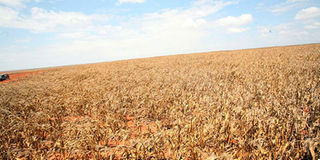Food insecurity sheds spotlight on State policies

The Galana-Kulalu irrigation project in Tana River County. It collapsed. PHOTO | FILE | NATION MEDIA GROUP
What you need to know:
- The NCPB, which buys grain for the strategic food reserve, has over the years been criticised for corruption and inefficiency.
- The World Bank also faulted the government’s failure to fix its subsidised fertiliser system, which it termed inefficient, opaque.
The government’s failure to administer medicine, some of which it prescribed for the ailing agricultural sector, is to blame for the country’s perennial food crisis.
A review of documents, some dating back to the years immediately after independence, shows that successive governments have been aware of the country’s arid conditions and the measures that needed to be taken, but did little, or nothing.
The World Bank, in its latest economic update, holds a dim view of the government’s commitment to reforming the sector, a major driver of the economy and source of employment for more than half of the population.
“With 83 per cent of Kenya’s land area being arid and semi-arid, one would expect use of irrigation in farming would be a top priority. Nonetheless, only two per cent of arable land is under irrigation, compared to an average of six per cent in sub-Saharan Africa and 37 per cent in Asia,” the report notes.
MISALLOCATION
It also favours small-scale irrigation projects over large ones such as the Galana-Kulalu, which went under with Sh7 billion, as the best way to cushion the country from climate change.
Dam projects worth Sh700 billion across the country have also stalled under a host of corruption claims.
The bank also criticises the government for its “outsized role in marketing agriculture outputs”, which it says results in the misallocation of resources and crowding out the private sector.
“This creates opportunity for rent-seeking by public officials and political elites and leaves little room for private sector participation in maize marketing,” the report notes.
It adds that the current practice, where the National Cereals and Produce Board (NCPB) buys maize at a premium price above that determined by market forces, results in unnecessary fiscal pressures and amounts to misallocation of resources from other potentially highly productive areas such as extension services.
CORRUPTION
The NCPB, which buys grain for the strategic food reserve, has over the years been criticised for corruption and inefficiency.
An audit last year revealed that it bought maize from well-connected traders who imported the grain from Uganda, at the expense of local farmers.
A Senate investigation also found maize worth billions of shillings rotting in NCPB stores.
The bank also faulted the government’s failure to fix its subsidised fertiliser system, which it termed inefficient, opaque, and does not reach the targeted smallholder farmers.
The document, which draws data from the Kenya National Bureau of Statistics, Central Bank of Kenya and National Treasury, puts the average fertiliser use at 30kg per hectare, compared to 100kg per hectare in Asia.
IRRIGATION
The report also blames the country’s poor productivity on generally small and shrinking farms, which are uneconomical.
Kenya’s food security plans have not benefitted from the country’s vibrant financial sector, the bank notes, as “only about four per cent of commercial bank lending is for agribusiness”.
The need for irrigated agriculture has been the consistent answer to Kenya’s food crisis.
Just before independence, the World Bank dispatched a mission to Kenya to assist the new nation develop planning tools for economic growth.
The Economic Development of Kenya (1963) report singled out irrigated agriculture for priority attention.
TARGET AREAS
The mission identified five basins with the greatest potential for rapid economic development through the exploitation of their waters. They were the Tana River, Athi River, Ewaso Nyiro, Lumi (Taveta) and Kenya Nile (Kano swamps reclamation) basins.
The acreage to be irrigated was as follows: Upper Tana Basin at 93,000 acres Lower Tana (400,000), the Kano plains (253,000), Ewaso Nyiro (75,000), Athi River (75,000), while Malawa and other catchments were to have 80,000 acres.
“It has been established that the Upper Tana basin has sufficient water and suitable black soils for the development of 15,000 acres of rice, 8,000 acres of red soil for such crops as tomatoes, onions, citrus, beans and fodder for livestock in the vicinity of Mwea,” the report notes.




